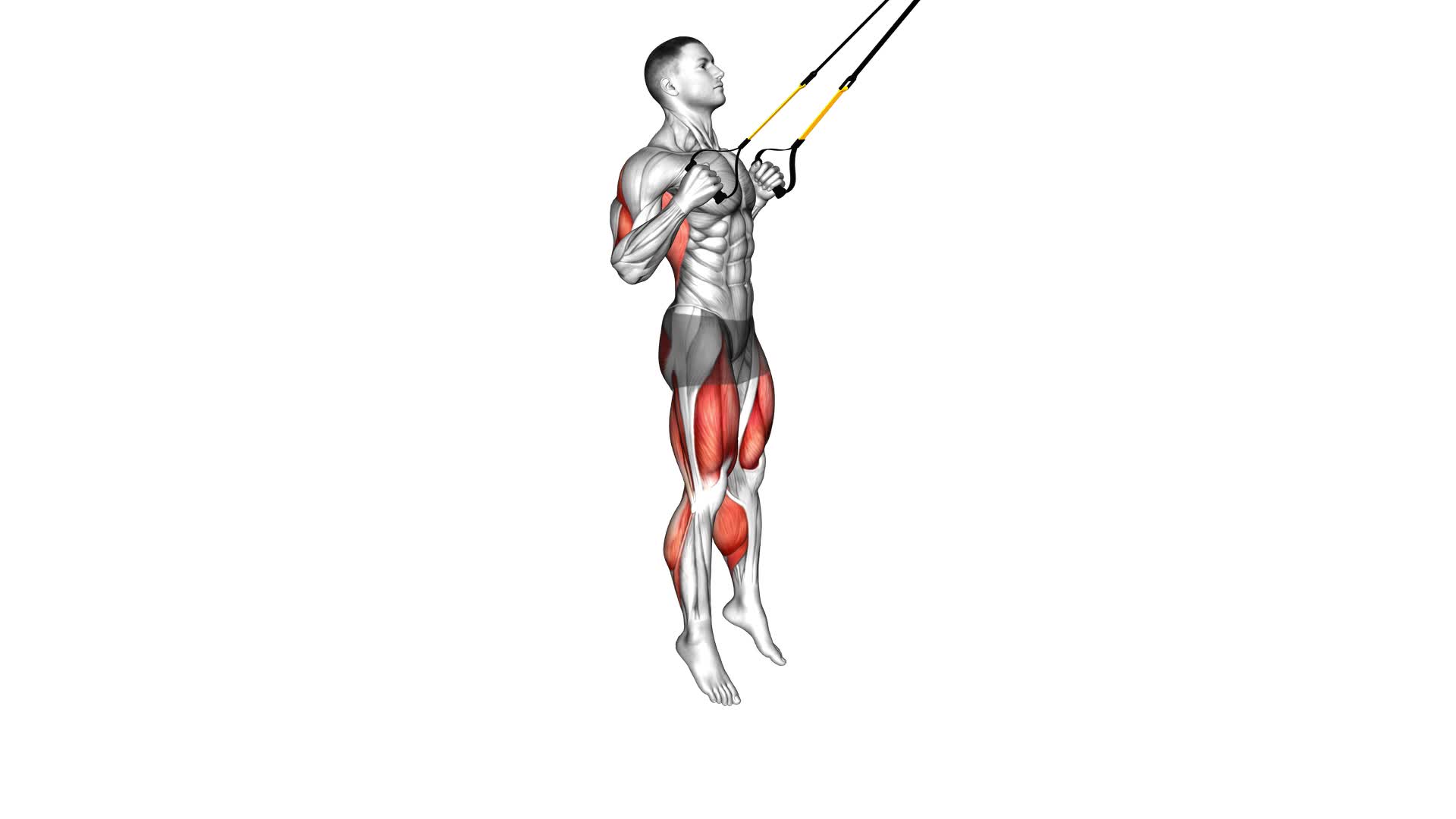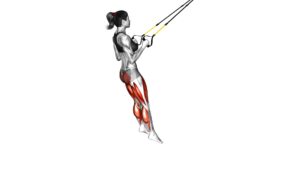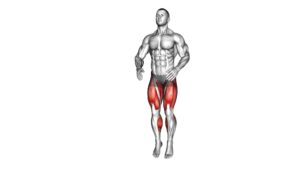Suspender Squat Jump (male) – Video Exercise Guide & Tips

Are you looking for a challenging exercise that will take your workout to the next level? Look no further than the suspender squat jump.
Watch This Exercise Video
This explosive movement targets your lower body and helps build strength and power.
In this video exercise guide, you'll learn proper form and technique, along with tips to maximize your results.
So grab a pair of suspenders and get ready to jump your way to fitness success!
Key Takeaways
- The Suspender Squat Jump improves explosive power, cardiovascular endurance, and lower body strength and power.
- Proper form and technique involve standing with feet shoulder-width apart, bending knees and lowering into a squat position, and jumping explosively while keeping the back straight and chest up.
- Common mistakes to avoid include not maintaining proper form, using too much momentum, landing with locked knees, failing to warm up properly, and ignoring the body's signals of overexertion.
- Modifications and progressions for beginners include mastering the basic squat movement before adding the jumping element, lowering the suspension point, performing partial squats, trying single-leg squats, and slowing down the tempo to focus on form and control. Advanced modifications for experts include adding resistance, performing on unstable surfaces, and increasing the intensity and strength required for the movement.
Benefits of Suspender Squat Jump
You can experience numerous benefits from incorporating the Suspender Squat Jump into your exercise routine. This exercise is highly effective in improving both explosive power and cardiovascular endurance. By performing the Suspender Squat Jump, you engage multiple muscle groups simultaneously, including your quadriceps, hamstrings, glutes, and calves. This leads to a significant increase in lower body strength and power.
One of the key benefits of the Suspender Squat Jump is its ability to enhance explosive power. This exercise requires you to exert maximum force in a short amount of time, which helps to develop the fast-twitch muscle fibers responsible for explosive movements. As a result, you'll see improvements in your ability to jump higher, sprint faster, and perform explosive movements in sports and activities.
Additionally, the Suspender Squat Jump is a fantastic exercise for improving cardiovascular endurance. The combination of squatting and jumping elevates your heart rate, challenging your cardiovascular system. By incorporating this exercise into your routine, you'll notice improvements in your overall stamina and endurance, allowing you to sustain physical activity for longer periods without feeling fatigued.
Incorporating the Suspender Squat Jump into your exercise routine is a great way to reap the benefits of explosive power and cardiovascular endurance. Whether you're an athlete looking to improve your performance or simply someone wanting to boost your fitness level, this exercise is worth including in your workouts.
Proper Form and Technique
To perform the Suspender Squat Jump with proper form and technique, focus on maintaining a strong and explosive movement throughout the exercise. Start by standing with your feet shoulder-width apart and your hands gripping the suspenders. Bend your knees and lower yourself into a squat position, keeping your back straight and your chest up. Make sure your knees don't extend past your toes to avoid unnecessary strain on your joints.
From the squat position, explosively jump upwards, extending your hips, knees, and ankles simultaneously. As you jump, swing your arms upward to help generate power. Land softly on the balls of your feet, bending your knees to absorb the impact. Avoid landing with your knees locked, as this can lead to injury.
Common errors in the Suspender Squat Jump include not fully extending the hips and knees during the jump, which reduces the effectiveness of the exercise. To improve, focus on fully extending your lower body and engaging your glutes and quadriceps muscles. Additionally, ensure that you maintain proper form throughout the exercise by keeping your back straight and chest up.
Practice these tips for improvement to maximize the benefits of the Suspender Squat Jump and reduce the risk of injury.
Equipment Needed for the Exercise
What equipment is required for the Suspender Squat Jump exercise?
When performing the Suspender Squat Jump, there are a few equipment options you can choose from to enhance your workout and ensure safety. Here are five items that you may consider using:
- Suspender Belt: This is the primary piece of equipment needed for the exercise. It consists of adjustable straps that attach to your body and provide resistance during the squat jump.
- Dumbbells: Adding dumbbells to your workout can increase the intensity and challenge your muscles even further. Start with lighter weights and gradually increase as you become more comfortable.
- Exercise Mat: A mat can provide cushioning and support, especially if you're performing the exercise on a hard surface. It helps to protect your joints and prevent any discomfort.
- Proper Footwear: Wearing supportive athletic shoes is essential to ensure stability and prevent any injuries. Opt for shoes that provide good ankle support and have a non-slip sole.
- Water Bottle: Staying hydrated during your workout is crucial. Keep a water bottle nearby to replenish your fluids and prevent dehydration.
When considering equipment options, always prioritize safety considerations. Choose equipment that's suitable for your fitness level and ensures proper form and technique. It's important to consult with a professional or fitness instructor if you're unsure about the equipment or its usage. Remember, safety should always be a top priority when exercising.
Common Mistakes to Avoid
When performing the Suspender Squat Jump, it's important to be aware of common mistakes that can hinder your progress and potentially lead to injury. One common mistake isn't maintaining proper form throughout the exercise. It's essential to keep your back straight, knees aligned with your toes, and your core engaged. Failing to do so can put unnecessary strain on your lower back and knees.
Another mistake to avoid is using too much momentum to propel yourself off the ground. Instead, focus on using your leg muscles to power the jump. Additionally, avoid landing with your knees locked, as this can lead to joint strain. Instead, land softly with a slight bend in your knees to absorb the impact.
To improve your performance, start with a lower jump height and gradually increase it as you gain strength and stability. Remember to warm up properly before attempting the Suspender Squat Jump and listen to your body to avoid overexertion. By avoiding these common mistakes and following these tips for improvement, you can maximize the benefits of the exercise and minimize the risk of injury.
Now, let's move on to the next section about modifications and progressions.
Modifications and Progressions
When it comes to the suspender squat jump, there are modifications and progressions that can be made to cater to different fitness levels.
For beginners, easier progressions can be implemented to gradually build strength and coordination.
On the other hand, experts can challenge themselves with advanced modifications to push their limits and continue improving.
These modifications and progressions allow individuals to customize the exercise and make it suitable for their specific needs and goals.
Easier Progressions for Beginners
To facilitate your progress as a beginner, modifications and progressions can be implemented to make the Suspender Squat Jump exercise more accessible. Here are some beginner-friendly modifications and progression variations that can help you build strength and improve your technique:
- Start with regular squats: Begin by mastering the basic squat movement before adding the jumping element. This will help you build a solid foundation of strength and stability.
- Use a lower suspension point: Lowering the suspension point of the straps can decrease the intensity of the exercise, making it more manageable for beginners.
- Reduce the depth of the squat: Instead of squatting all the way down, focus on performing partial squats to gradually increase your range of motion over time.
- Perform single-leg squats: If you find it challenging to perform the exercise with both legs, try doing it one leg at a time to build strength and balance.
- Slow down the tempo: Slowing down the movement can help you focus on proper form and control, allowing you to gradually increase the difficulty as you become more comfortable.
Advanced Modifications for Experts
To further challenge yourself and continue improving your skills, advanced modifications and progressions can be incorporated into the Suspender Squat Jump exercise.
These advanced variations will push your limits and take your workout to the next level.
One advanced technique is to add resistance to the exercise by wearing a weighted vest or holding onto dumbbells while performing the squat jump. This will increase the intensity and strength required for the movement.
Another option is to perform the exercise on an unstable surface, such as a Bosu ball or balance board. This will challenge your stability and core strength even more.
Remember to always maintain proper form and start with lighter weights or progressions before attempting these advanced techniques.
Tips for Maximizing Results
To maximize your results with the Suspender Squat Jump, focus on maintaining proper form throughout the exercise. This will ensure that you're targeting the right muscles and minimizing the risk of injury. Here are some tips to help you get the most out of your workout:
- Maximize Intensity: Push yourself to jump as high as you can during each repetition. This will increase the intensity of the exercise and help you build explosive power in your legs.
- Increase Training Frequency: Incorporate the Suspender Squat Jump into your routine at least 2-3 times a week. Consistency is key when it comes to seeing results, so make sure to prioritize this exercise regularly.
- Engage your Core: Throughout the exercise, remember to engage your core muscles. This will help stabilize your body and improve your balance and coordination.
- Land Softly: When you land from each jump, aim to land softly and absorb the impact with your legs and muscles, rather than your joints. This will reduce the risk of knee or ankle injuries.
- Listen to your Body: Pay attention to how your body feels during the exercise. If you experience any pain or discomfort, modify the exercise or consult a professional for guidance.
Frequently Asked Questions
How Many Sets and Repetitions Should I Perform for the Suspender Squat Jump Exercise?
To determine the suitable repetitions and sets for the suspender squat jump exercise, consider your fitness level and goals. You can start with 2-3 sets of 10-12 repetitions, gradually increasing as you get stronger.
This exercise helps improve lower body strength, explosive power, and overall athleticism. By incorporating suspension training, it adds an extra challenge to your squat jump, engaging more muscles and enhancing stability.
Can the Suspender Squat Jump Exercise Be Performed by Beginners or Is It More Suitable for Advanced Individuals?
The suspender squat jump exercise can be performed by beginners, but it's more suitable for advanced individuals looking for a challenge. Beginners can modify the exercise by using lighter weights or starting with regular squat jumps before progressing to the suspender version.
This exercise offers numerous benefits for advanced individuals, such as increased lower body strength, explosive power, and improved overall athleticism.
It's important to focus on proper form and start with lower intensity before advancing.
Are There Any Specific Warm-Up Exercises or Stretches Recommended Before Performing the Suspender Squat Jump?
Before performing the suspender squat jump, it's important to do proper warm-up exercises and stretches. This will help prepare your muscles and joints for the intense movement of the exercise.
Focus on dynamic movements like leg swings, hip circles, and bodyweight squats to increase blood flow and activate the muscles.
Additionally, incorporate stretches like hip flexor stretches and hamstring stretches to improve flexibility and prevent injury.
Should I Wear Any Specific Type of Shoes or Clothing for the Suspender Squat Jump Exercise?
For the suspender squat jump exercise, it's important to wear the right shoes and clothing.
Wearing proper shoes with good support can help prevent injuries and provide stability during the exercise. Opt for athletic shoes with a flat sole and good cushioning.
As for clothing, choose comfortable and breathable attire that allows for a full range of motion. Avoid loose-fitting clothes that may get caught on the suspenders or hinder your movements.
Can the Suspender Squat Jump Exercise Be Incorporated Into a Full-Body Workout Routine, or Is It More Effective as a Standalone Exercise?
Incorporating the suspender squat jump into a full-body workout routine can be a great way to elevate your fitness level. This exercise targets multiple muscle groups, including your legs, glutes, and core. It adds a plyometric element to your routine, increasing power and explosiveness.
However, it's also effective as a standalone exercise if you want to focus solely on lower body strength and power. Remember to always consult with a fitness professional to ensure proper form and technique.
Conclusion
In conclusion, the suspender squat jump is a highly beneficial exercise for males that targets multiple muscle groups and improves explosive power.
By following proper form and technique, using the necessary equipment, and avoiding common mistakes, individuals can maximize their results and prevent injury.
Additionally, modifications and progressions can be implemented to challenge oneself further.
Incorporating this exercise into a workout routine can lead to improved strength, agility, and overall athletic performance.

Author
Years ago, the spark of my life’s passion ignited in my mind the moment I stepped into the local gym for the first time. The inaugural bead of perspiration, the initial endeavor, the very first surge of endorphins, and a sense of pride that washed over me post-workout marked the beginning of my deep-seated interest in strength sports, fitness, and sports nutrition. This very curiosity blossomed rapidly into a profound fascination, propelling me to earn a Master’s degree in Physical Education from the Academy of Physical Education in Krakow, followed by a Sports Manager diploma from the Jagiellonian University. My journey of growth led me to gain more specialized qualifications, such as being a certified personal trainer with a focus on sports dietetics, a lifeguard, and an instructor for wellness and corrective gymnastics. Theoretical knowledge paired seamlessly with practical experience, reinforcing my belief that the transformation of individuals under my guidance was also a reflection of my personal growth. This belief holds true even today. Each day, I strive to push the boundaries and explore new realms. These realms gently elevate me to greater heights. The unique combination of passion for my field and the continuous quest for growth fuels my drive to break new ground.



